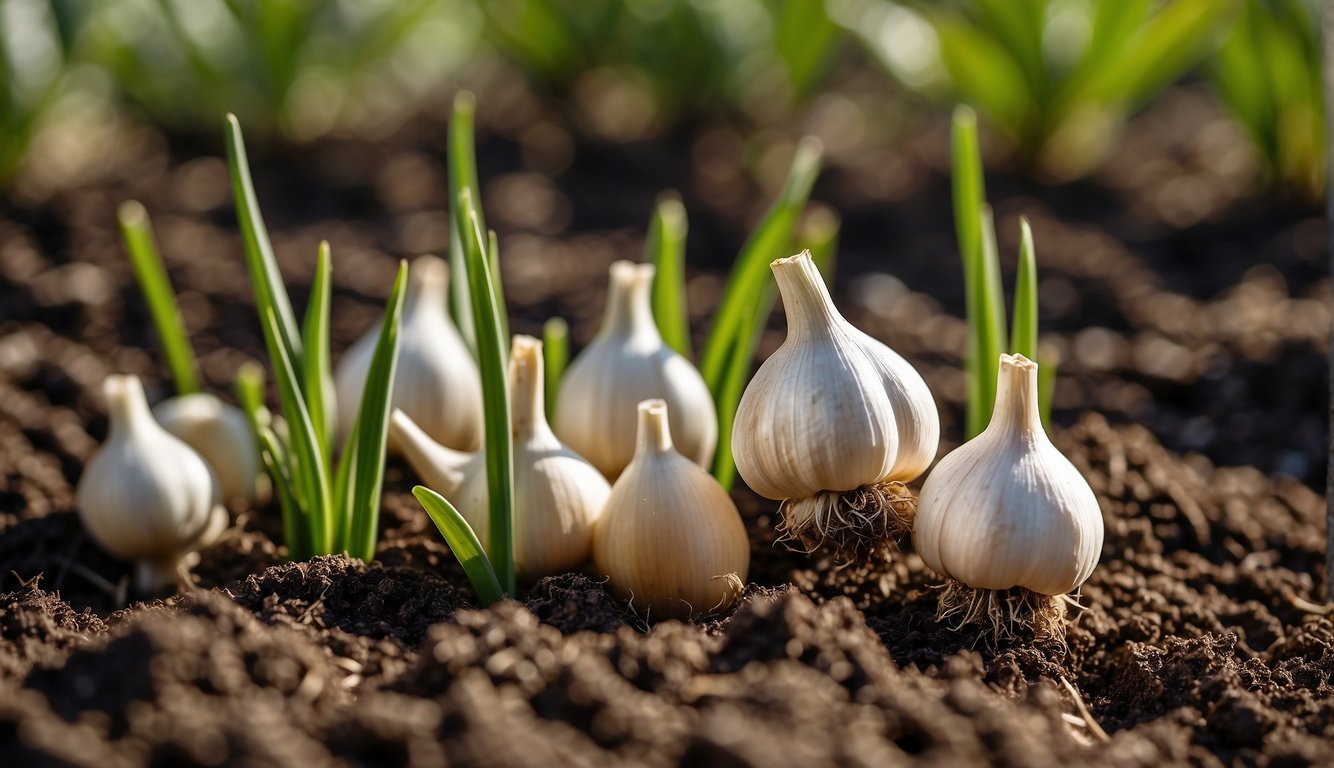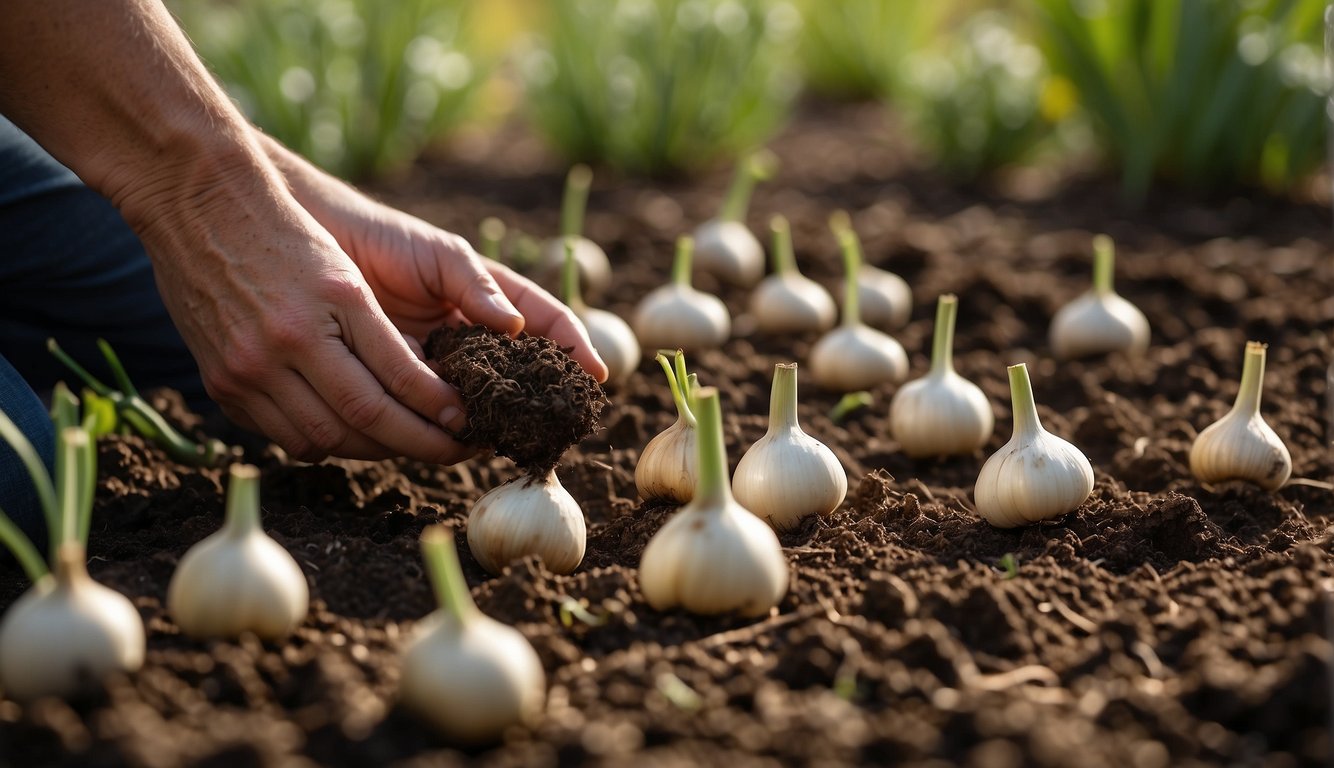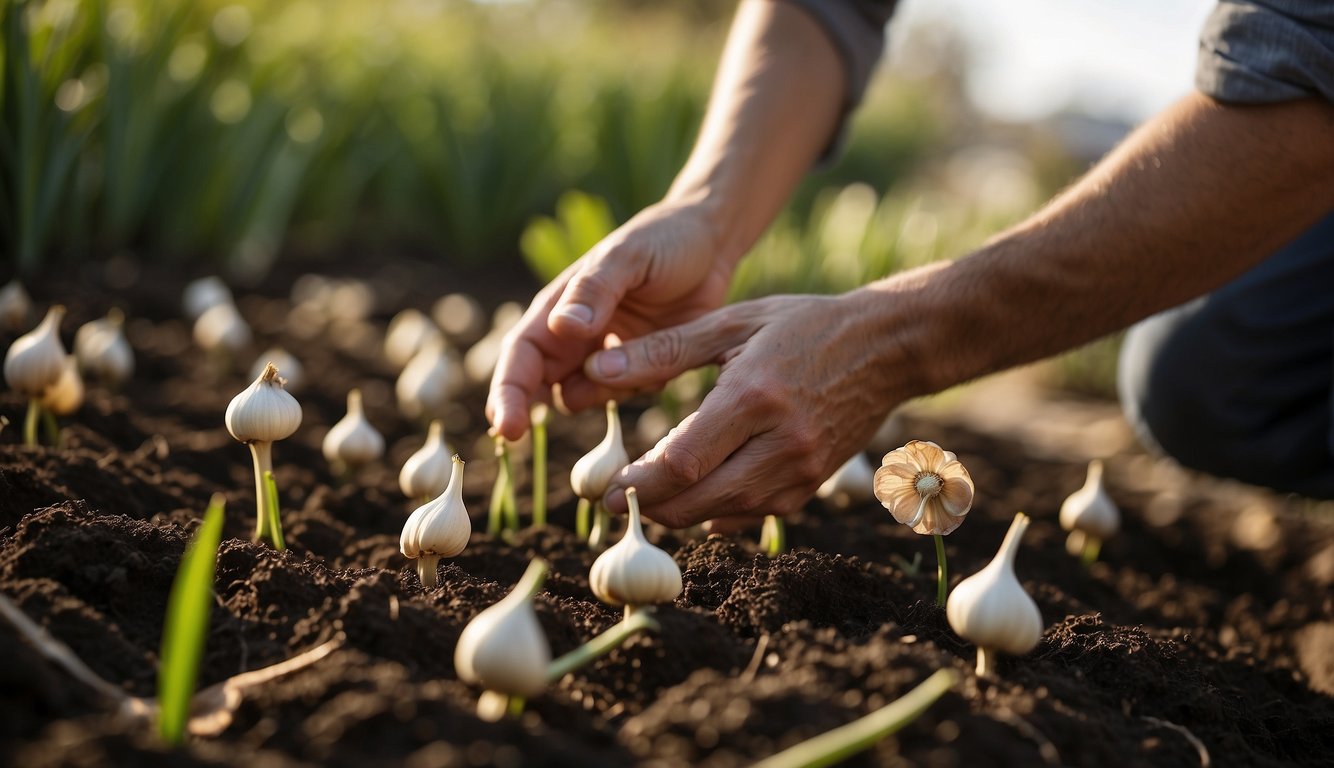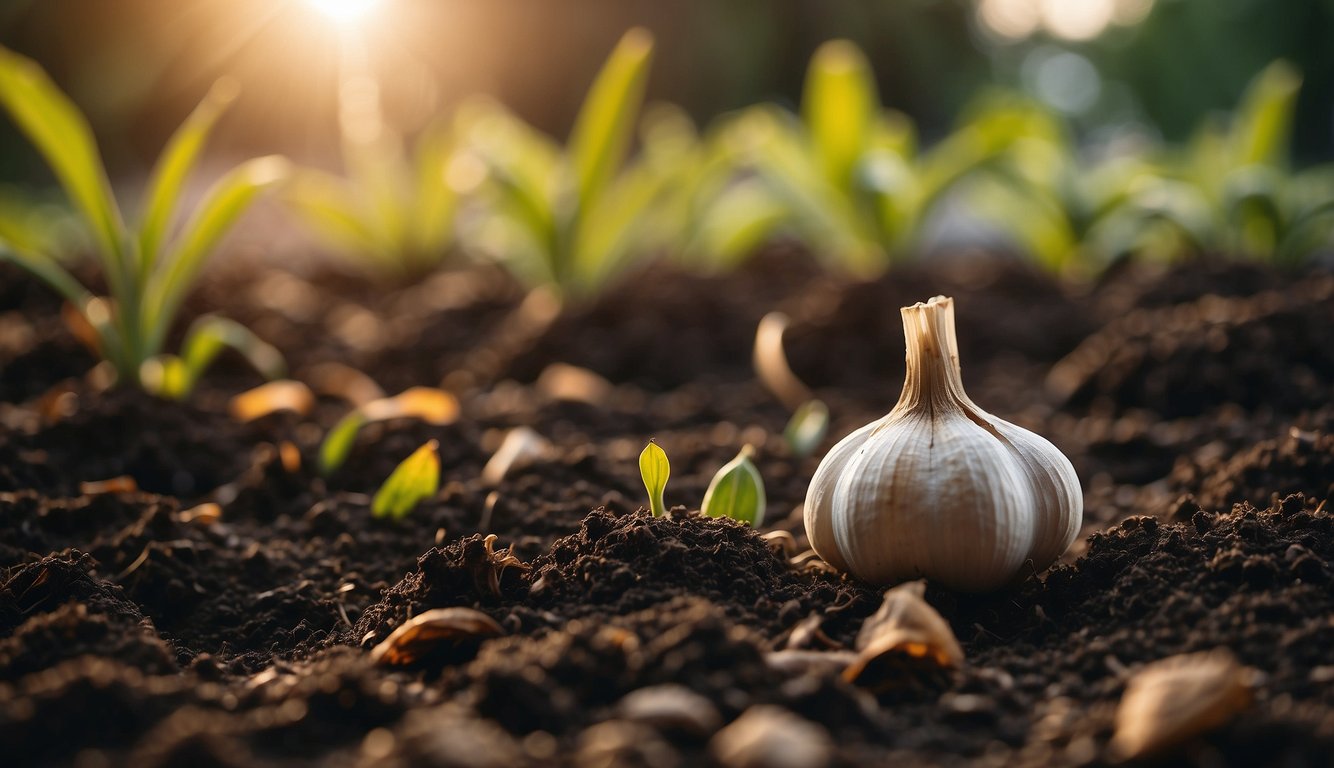TheHerbProf.com is a treasure trove of knowledge for those interested in natural healing and herbal remedies. The website is run by Paul Johnston MD. A naturopathic who has not only received extensive education in the field but also has personal experience in self-healing.
I love planting garlic in my garden, but sometimes I forget to plant it in the fall. This has led me to wonder if I can plant garlic in the spring and still get a good harvest. After doing some research, I have found that it is possible to plant garlic in the spring and get a decent harvest.
While fall is the ideal time to plant garlic, planting in the spring is still a viable option. According to Better Homes & Gardens, you can plant garlic in the spring and still get a harvest. However, there are a few things to keep in mind. Garlic cloves need a cold period to trigger bulb development, so it’s important to make sure the cloves have been refrigerated for a few weeks before planting. Additionally, spring-planted garlic may not produce the large bulbs that fall-planted garlic does, but it is still possible to get a decent harvest.
If you’re planning on planting garlic in the spring, there are a few things you should keep in mind. According to Savvy Gardening, it’s important to make sure the soil is well-draining and has been amended with compost or other organic matter. Garlic prefers a soil pH of 6.0 to 7.0, so it’s a good idea to have your soil tested before planting. Additionally, garlic should be planted in an area that receives full sun. With the right soil conditions and proper care, it is possible to plant garlic in the spring and still get a good harvest.
Benefits of Spring Garlic Planting
As a gardener, I have found that spring garlic planting has many benefits. While planting garlic in the fall is the traditional method, planting garlic in the spring can still yield a great harvest with a few tips and tricks. Here are some of the benefits of planting garlic in the spring:
Flavor and Culinary Uses
Spring garlic has a milder flavor than fall garlic, making it perfect for those who want to add garlic to their dishes without overpowering the other flavors. It also has a fresher taste, which is perfect for dishes that require raw garlic, such as salads and dips. Additionally, spring garlic has a higher moisture content, which makes it easier to peel and chop.
Health Benefits
Garlic is known for its many health benefits, including its ability to boost the immune system, lower blood pressure, and reduce the risk of heart disease and cancer. Spring garlic is no exception. In fact, according to Creative Vegetable Gardener, spring garlic has a higher concentration of allicin, a compound that has been shown to have antibacterial and antifungal properties, than fall garlic.
In addition, garlic is also rich in vitamins and minerals, such as vitamin C, vitamin B6, and manganese. These nutrients are essential for maintaining a healthy immune system, nervous system, and metabolism.
Overall, planting garlic in the spring can be a great way to add flavor to your dishes and boost your health. Whether you are a seasoned gardener or just starting out, planting garlic in the spring is a fun and rewarding experience.
Preparation for Planting Garlic in Spring

As a gardener, I prefer to plant garlic in the fall, but it is possible to plant garlic in the spring. Here are some tips on how to prepare for planting garlic in the spring.
Choosing the Right Garlic Varieties
When planting garlic in the spring, it is important to choose the right garlic varieties. Softneck garlic varieties are better suited for spring planting as they have a shorter vernalization period, which means they do not need as much cold exposure to form bulbs. Hardneck garlic varieties require a longer vernalization period and are best planted in the fall.
Soil Preparation and Amendments
Soil preparation is crucial for planting garlic in the spring. Garlic prefers well-draining soil with a pH between 6.0 and 7.0. Before planting, loosen the soil to a depth of at least 8 inches, and add organic compost to improve soil structure and fertility. The compost will also help to retain moisture in the soil.
Vernalization Process for Spring Planting
Vernalization is the process of exposing garlic cloves to a period of cold temperatures to stimulate bulb formation. When planting garlic in the spring, it is important to vernalize the garlic cloves before planting. To do this, place the garlic cloves in a paper bag and store them in the refrigerator for 4-6 weeks before planting. This will mimic the cold temperatures of winter and stimulate bulb formation.
Planting garlic in the spring is possible with the right preparation. Choose softneck garlic varieties, prepare the soil with organic compost, and vernalize the garlic cloves before planting. With proper care, you can have a successful garlic harvest in the summer.
Garlic Planting Techniques

Planting garlic in the spring is a great way to grow this flavorful and healthy crop. Here are some techniques to help you plant garlic successfully.
Planting Individual Cloves
When planting garlic, you’re planting the individual cloves, not the entire bulb. Make sure you use high-quality garlic cloves that are free from disease and damage. To plant, separate the cloves from the bulb and plant them with the pointed end facing up and the flat end facing down.
Spacing and Depth for Garlic Bulbs
Garlic bulbs need enough space to grow properly. Space your garlic cloves about 6 inches apart in rows that are 12 inches apart. Plant your garlic cloves about 2 inches deep in well-draining soil. If your soil is heavy or clay-like, add some organic matter to improve drainage.
Using Containers and Raised Beds
If you don’t have a lot of space in your garden, you can still grow garlic by using containers or raised beds. When using containers, make sure they are at least 12 inches deep and wide enough to accommodate the number of garlic cloves you want to plant. Fill the containers with well-draining soil and plant the garlic cloves as you would in the ground.
Raised beds are a great option if you have poor soil or drainage issues. Build a raised bed that is at least 6 inches deep and fill it with well-draining soil. Plant your garlic cloves as you would in the ground, spacing them about 6 inches apart in rows that are 12 inches apart.
By following these garlic planting techniques, you can grow healthy and flavorful garlic in the spring.
Garlic Growth and Care

As I mentioned earlier, planting garlic in the spring is possible, and with proper care and management, you can still get a good harvest. In this section, I will discuss some of the essential aspects of garlic growth and care that you need to keep in mind.
Watering and Moisture Management
Garlic needs regular watering to grow and develop properly. However, it is crucial to avoid overwatering, as it can lead to root rot and other fungal diseases. I usually water my garlic plants every 4-5 days, depending on the weather conditions. During hot and dry periods, you may need to water more frequently.
It is also essential to ensure proper drainage to prevent waterlogging and root rot. You can achieve this by planting garlic in well-drained soil or raised beds. If you are planting garlic in heavy clay soil, you can amend it with organic matter such as compost or aged manure to improve drainage and water retention.
Mulching and Weed Control
Mulching is an effective way to control weeds, conserve moisture, and regulate soil temperature. Organic mulches such as straw, leaves, or grass clippings work best for garlic plants. I usually apply a layer of mulch about 2-3 inches thick around the garlic plants, making sure to keep it away from the stem.
Mulching also helps to prevent soil erosion and nutrient leaching, which can lead to nutrient deficiencies. However, it is important to avoid over-mulching, as it can create a favorable environment for pests and diseases.
Fertilization and Nutrient Requirements
Garlic plants require adequate nutrients to grow and develop properly. Before planting, you can amend the soil with organic matter such as compost or aged manure to improve soil fertility. You can also apply a balanced fertilizer such as 10-10-10 or 20-20-20 at a rate of 1-2 pounds per 100 square feet.
It is important to avoid over-fertilizing, as it can lead to excessive vegetative growth and delay bulb formation. You can also apply a side-dressing of nitrogen fertilizer such as blood meal or fish emulsion when the garlic plants reach about 6-8 inches tall to promote healthy growth.
Growing garlic in the spring requires proper care and management to ensure a good harvest. By following the tips and techniques discussed in this section, you can grow healthy and robust garlic plants and enjoy a bountiful harvest.
Common Challenges and Solutions – Can You Plant Garlic in the Spring?

Pest and Disease Management
When planting garlic in the spring, it is important to be aware of potential pests and diseases that may affect your crop. Some common pests that can damage garlic include onion thrips, nematodes, and wireworms. To prevent these pests from causing damage, it is important to practice good crop rotation and to keep the soil well-drained and free of weeds. Additionally, you can use organic pest control methods such as companion planting or the use of beneficial insects like ladybugs to help control pest populations.
Diseases such as white rot and downy mildew can also be a concern when planting garlic in the spring. To prevent these diseases from spreading, it is important to practice good sanitation practices, such as removing any infected plants or debris from the garden. Additionally, you can use organic fungicides such as copper sprays to help control the spread of disease.
Dealing with Weather Variability – Can You Plant Garlic in the Spring?
One of the biggest challenges of planting garlic in the spring is dealing with weather variability. Garlic is a cool-season crop and can be damaged by hot temperatures or frost. To prevent damage from frost, it is important to plant garlic early enough in the spring to allow it to establish roots before the ground freezes. Additionally, you can use mulch or row covers to protect the plants from frost.
Hot temperatures can also be a concern when planting garlic in the spring. To prevent damage from heat stress, it is important to plant garlic in a location that receives partial shade during the hottest part of the day. Additionally, you can water the plants regularly to help keep the soil cool and moist.
Garlic Bolting and Scapes
Garlic bolting and scapes can be a concern when planting garlic in the spring. Bolting occurs when the garlic plant produces a flower stalk instead of a bulb. To prevent bolting, it is important to plant garlic at the right time and to choose varieties that are less prone to bolting. Additionally, you can remove any flower stalks as soon as they appear.
Scapes are the curly stems that grow from the garlic plant and can be harvested for culinary use. To encourage the production of scapes, it is important to plant hardneck garlic varieties and to remove any flower stalks as soon as they appear. Additionally, you can use the scapes in a variety of dishes, such as pesto or stir-fry.
Harvesting and Curing Garlic – Can You Plant Garlic in the Spring?

As a garlic grower, I know that harvesting garlic is an exciting moment. It’s the time when you get to see the fruits of your labor and enjoy the delicious taste of freshly harvested garlic. However, it’s important to know when to harvest garlic to ensure that you get the best quality and flavor.
Recognizing Garlic Maturity
Garlic is usually ready for harvesting in late spring or early summer, depending on when it was planted. You can tell when garlic is mature by looking at the leaves. When the leaves start to turn brown and fall over, it’s a sign that the garlic is ready for harvest. Another way to check for maturity is to dig up a bulb and inspect it. The cloves should be plump and fully formed.
Proper Techniques for Harvesting Garlic – Can You Plant Garlic in the Spring?
To harvest garlic, use a garden fork or shovel to loosen the soil around the bulbs. Be careful not to nick or bruise the bulbs, as this can cause them to spoil during storage. Once the garlic is loosened, gently pull it out of the ground by the stem.
After harvesting, it’s important to clean the garlic bulbs. Remove any dirt or debris from the bulbs by gently brushing them with a soft brush or cloth. Do not wash the bulbs with water, as this can cause them to rot during storage.
Curing and Storage for Longevity
Curing is the process of drying garlic after it has been harvested. This is an important step in the process, as it helps to extend the shelf life of the garlic. To cure garlic, hang the bulbs in a warm, dry, and well-ventilated area for two to three weeks. Once the garlic is fully cured, trim the roots and stems and store the bulbs in a cool, dry place.
It’s important to store garlic properly to ensure that it lasts as long as possible. Garlic can be stored in a variety of ways, including in a mesh bag, in a paper bag, or in a well-ventilated container. Do not store garlic in the refrigerator, as this can cause it to sprout and become bitter.
Harvesting and curing garlic is a simple process that requires a bit of patience and attention to detail. By following these simple techniques, you can ensure that your garlic is of the highest quality and flavor.
Integrating Garlic into Your Garden – Can You Plant Garlic in the Spring?

Garlic is a versatile plant that can be grown in various settings, including vegetable gardens, herb gardens, and flower beds. Here are some tips on how to integrate garlic into your garden:
Companion Planting with Garlic – Can You Plant Garlic in the Spring?
Garlic is a natural pest repellent, making it an excellent companion plant for other vegetables. It can help repel pests such as aphids, carrot flies, and spider mites, making it an ideal companion for carrots, daffodils, and other plants that are prone to pest infestations. In addition, garlic can help improve soil health by increasing the amount of organic matter in the soil, which can benefit neighboring plants.
Garlic as a Perennial Herb
Garlic is a perennial herb that can be grown in garden beds or containers. When planting garlic, it is important to choose a sunny location with well-drained soil. Garlic requires consistent moisture, but it does not tolerate waterlogged soil. To ensure that your garlic plants thrive, it is essential to keep the soil moist but not waterlogged.
Garlic can be grown as a single plant or in clusters, depending on the size of your garden bed. When planting garlic, it is important to space the cloves at least six inches apart to allow room for growth. Garlic can be harvested in the spring or fall, depending on when it was planted. When harvesting garlic, it is important to wait until the leaves have turned brown and dried out before digging up the bulbs.
Garlic is a versatile plant that can be integrated into various garden settings. Whether you are planting it as a companion plant or as a perennial herb, garlic can help improve soil health and repel pests, making it an excellent addition to any garden.
Can You Plant Garlic in the Spring?
Today, we’re digging into a question that might surprise you – Can you plant garlic in the spring? The answer is yes!
That’s right, folks! While garlic is traditionally planted in the fall, it can also be planted in the spring. It’s like a second chance for garlic lovers!
Now, the planting part. Just like fall planting, you’ll want to plant the cloves pointy end up. It’s like they’re reaching for the sky!
And here’s a fun fact! Spring-planted garlic may not grow as large as fall-planted garlic, but it will still be delicious. It’s like a mini version of your favorite flavor booster!
So, next time spring rolls around, why not plant some garlic? Your future meals will thank you!
For more gardening wisdom, do visit the website theherbprof.com. Keep it garlicky, folks!
References – Can You Plant Garlic in the Spring?
Little Herb Encyclopedia, by Jack Ritchason; N.D., Woodland Publishing Incorporated, 1995
The Ultimate Healing System, Course Manual, Copyright 1985, Don Lepore
Planetary Herbology, Michael Tierra, C.A., N.D., Lotus Press, 1988
Handbook of Medicinal Herbs, by James A. Duke, Pub. CRP Second Edition 2007
The Complete Medicinal Herbal, by Penelope Ody, Published by Dorling Kindersley
Check the Following Articles!
How to Use Coffee Grounds in Potted Plants?
Basil and Tomato Companion Planting: Successful Pairing
Grow Your Own Food from Scraps: Sustainable Garden
Frequently Asked Questions – Can You Plant Garlic in the Spring?

What are the best practices for planting hardneck garlic in the spring?
When planting hardneck garlic in the spring, it is important to choose a well-draining location that receives full sun. The soil should be rich in organic matter and have a pH of 6.0 to 7.0. To plant, break the garlic bulb into individual cloves and plant them 2-3 inches deep and 4-6 inches apart. Mulch with straw or leaves to retain moisture and control weeds.
Which companion plants are recommended when growing garlic in spring?
Garlic is a natural pest repellent and can be planted alongside other vegetables and herbs to deter pests. Some recommended companion plants for garlic include tomatoes, peppers, lettuce, and chamomile.
Should garlic cloves be chilled before spring planting, and if so, how?
Garlic cloves need a cold period to trigger bulb development. If you are planting in the spring, you can chill the cloves in the refrigerator for 2-4 weeks before planting. Alternatively, you can purchase pre-chilled cloves from a reputable supplier.
What are the considerations for planting garlic in spring in different USDA zones?
The best time to plant garlic in the spring varies depending on the USDA hardiness zone. In zones 5-7, garlic can be planted in early spring, while in zones 8-10, it is best to wait until late winter or early spring. It is important to choose a variety of garlic that is adapted to your specific zone.
How can you successfully grow garlic in pots during the spring season?
To grow garlic in pots during the spring season, choose a container that is at least 8 inches deep and has drainage holes. Fill the container with a well-draining potting mix and plant the cloves 2-3 inches deep and 4-6 inches apart. Water regularly and fertilize with a balanced fertilizer every 4-6 weeks.
Are there any specific tips for planting onions alongside garlic in the spring?
Onions can be planted alongside garlic in the spring, as they have similar growing requirements. Plant the onions 4-6 inches apart, and make sure to water regularly. Onions can also be used as a natural pest repellent when planted alongside garlic.


